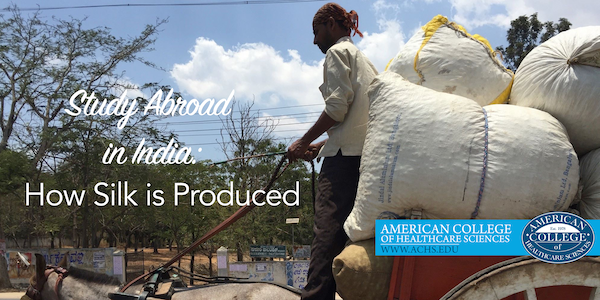
We wrestle free from the gridlock traffic of Bangalore, and begin down the long road to Mysore. On the way, we stop at one of the many coconut lean-tos, where our lady in her bright-pink sari deftly takes a machete to the tough coconut husk, and inserts a straw for us to drink the electrolyte-rich water.
Once emptied, I cringe slightly, worried she may cut herself as she retrieves the husk to hack it up again, creating a “spoon” with one of the pieces so we can dig out the meat. With the nearly 106-degree temperature, it’s no wonder these coconut lean-to refreshment stations, the equivalent of our 7-Elevens, are everywhere.

Traveling on, we begin to get used to the constant sound of horns, which are used as a communication tool, and the perpetual game of “chicken” that our driver, Thomas, whose eyes never leave the road, masters with ease. His confidence, which he attributes to his trust in God, puts us at ease as we continue down the narrow, two-lane roads full of pedestrians, motorcycles, trucks, carts, bicycles, and cows that lead to our destination. Here is a short video of driving in India.
We just make the Cocoon Market before they close. Out front are several motorcycles, trucks, and carts awaiting their load of cocoons. We enter the open-air building under the archway marked “Government Cocoon Market, Ramanagara.”
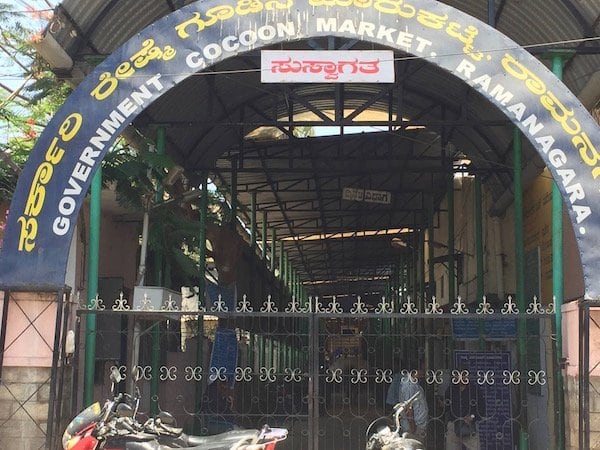
Once inside, we are in a long rectangular building, with two long rows of green metal bins full of thousands of white silk cocoons. The traders are working diligently to make their last sales of the day.
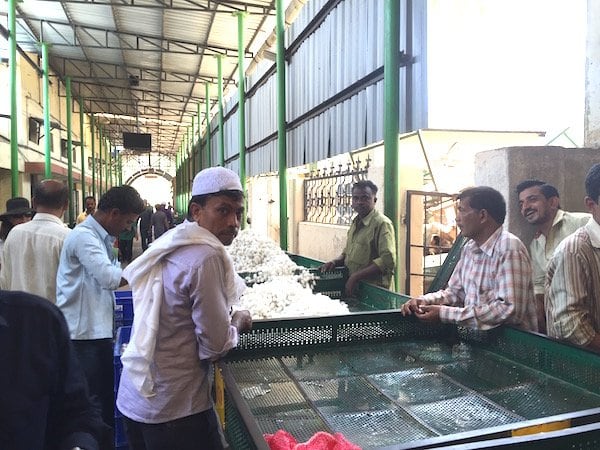
Some are already finished, and we find one man sleeping in his empty bin.
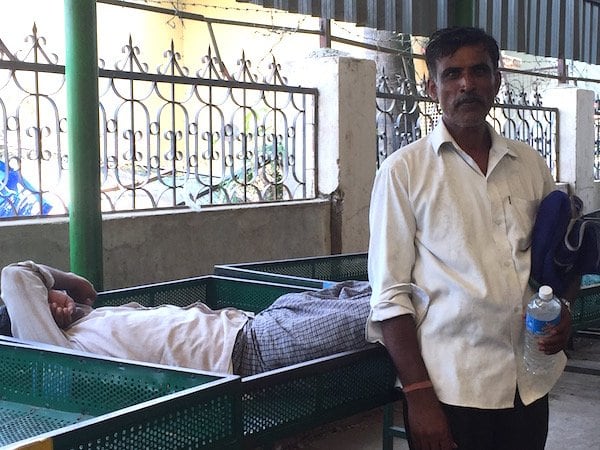
It’s best not to think about the fact that the pupae inside each cocoon will be giving up their lives as butterflies for this process. But, allowing them to hatch destroys the thread. To get the billions of cocoons necessary to have a viable silk industry (it takes about 2,500 cocoons to make a single pound of raw silk), the worms are cultivated.
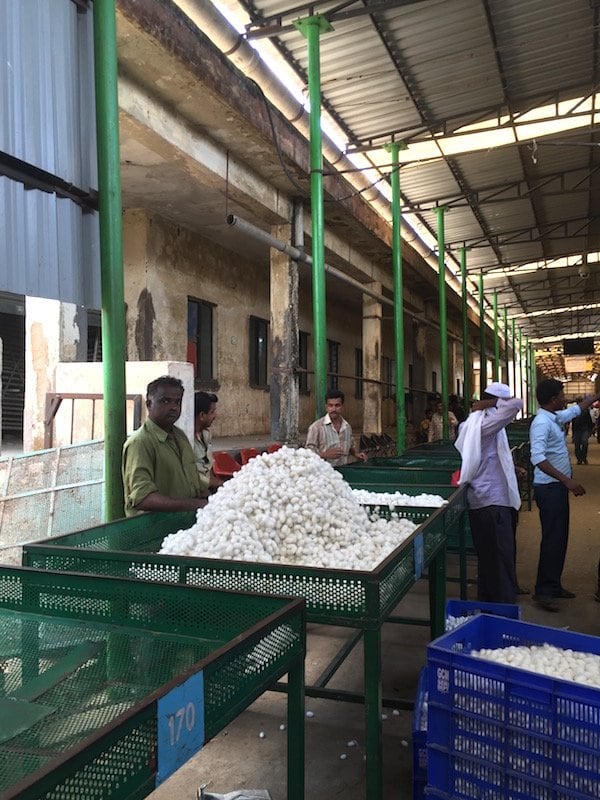
It turns out that:
To harvest the silk, the cocoon is placed in either boiling water, or blasted with steam or hot air, all processes that kill the pupae. Less lethal methods were tried in the past, such as pulling the silk as the worms spun it, but the worms resisted and bit off the filaments (the longest thread harvested in this way was just 6 meters).
Besides killing the pupae, the heat softens the binding agent (sericin), so that the filaments may be unwound. Sometimes, the softened sericin is left on the fibers, and this product is called raw silk.
From there, raw silk strands are twisted together until a fiber of sufficient strength for knitting or weaving is produced. Different twisting methods produce a different type of thread: crepe, thrown, tram, organzine, or singles. Crinkly fabrics are made with crepe, while sheer cloth is made with single thread. Spun silk is comprised of broken filaments that have been processed into a yarn[1].
As things wrap up at the market, customers load their huge bags of cocoons onto an array of oxen-drawn carts, small trucks, and even on their heads as they get on their bicycles.
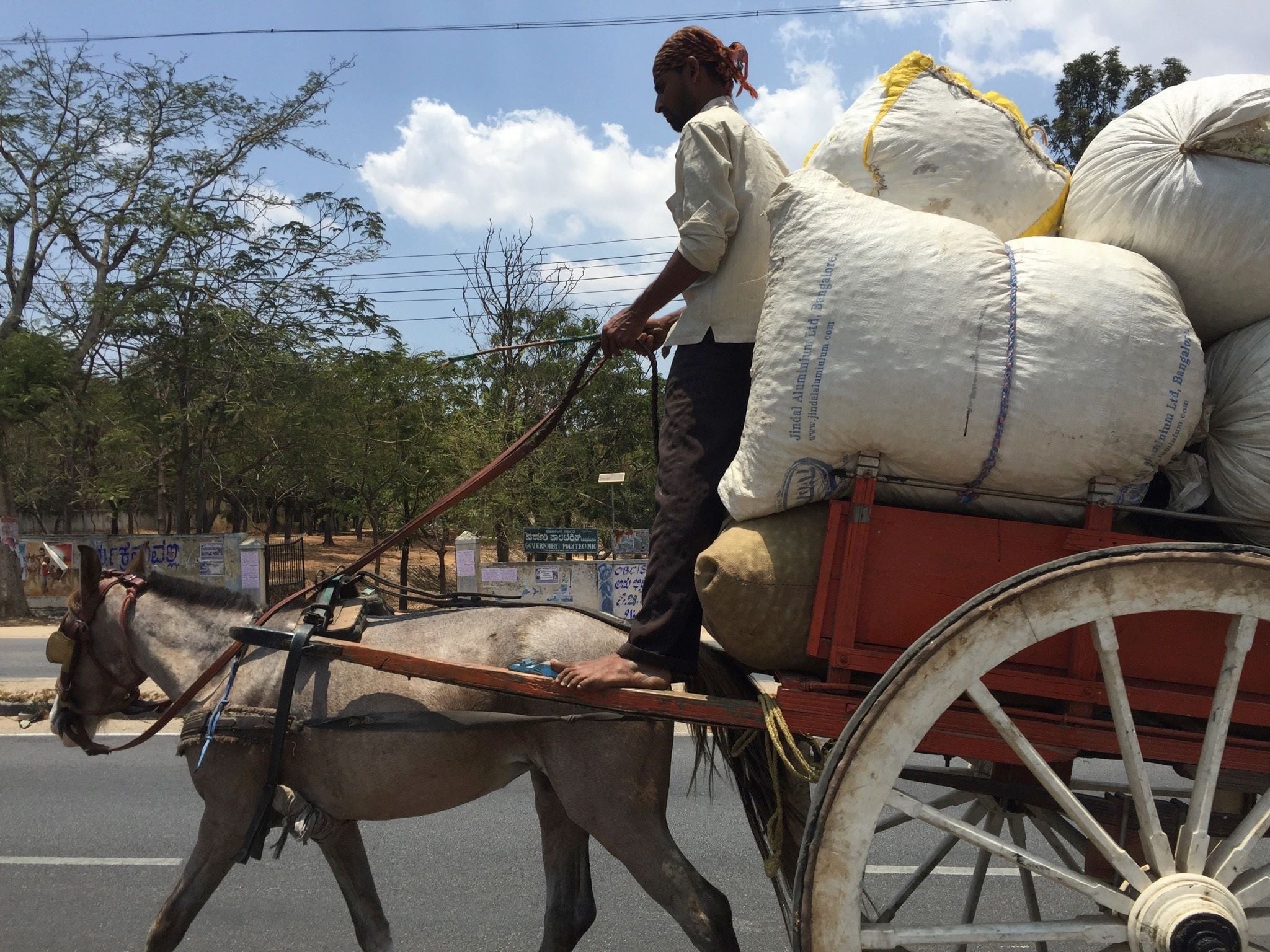

The cocoons will be taken to various production facilities where the silk is spun onto rolls, dyed, and used to make beautiful silk clothing.
While in Mysore, we visit the “Mysore Silk” factory. Upon entry, we make sure to hand our cameras to Thomas, who waits with the car, as the factory has a strict no photography rule. Right off the bat, we are told we will not be permitted to see the first step in the process—the steaming of the cocoons. We ask “why” and are told it is proprietary.
As we enter the heavily regulated building, it reminds me of Willy Wonka’s Chocolate Factory, and I wonder what secrets will be revealed inside (and if we might see any Oompa Loompas).
We enter the first of a handful of very large rooms humming with machinery. The noise produced by these machines is so loud that we make a note to bring earplugs next time we come.
The first room is actually a small alcove in which the raw silk thread is boiled in soap and coconut oil. There is no air-conditioning, and the room, with its huge vats of boiling liquid, is stifling. Despite these conditions, the two men running this process are eager to speak with us, and have so much pride in their work. One man tells us he had been doing it for 30 years.
The second room contains rows of machines, all operated by women that are creating the silk thread. The silk thread is so fine, that when I look at a machine, I can’t even see the strand. The only evidence is that I can see the roll is getting larger. It’s a colorful room because of the variety of bright look-alike saris worn by the women. Since Mysore Silk is known for sari production, I wonder if their sari uniforms are provided by the company as a perk of the job.
Next we move into the room that begins the process of weaving the silk thread into bolts of silk cloth These machines are seemingly more complex, and we can’t help but notice that each one is operated by a man.
The largest room is also “manned” by only men. These machines have panels that remind me of a player piano. Each strand of the appropriately colored silk is woven through a particular hole, which creates the tapestry of color for the specific sari design. They even weave pure gold into certain saris. (KSIC silk products are 100% pure silk blended with 100% pure gold zari thread, which is 65% silver and 0.65% gold.)
And finally, in one section of the largest room, there are large pots of boiling dye. Once the sari is woven, the entire garment is dyed. Interesting to note that the gold zari thread doesn’t take the dye, so remains gold after this process.
According to the factory website, it “started with 10 looms in 1930 under the rulers of erstwhile Mysore Kingdom, and today boasts more than 159 looms, two Warping machines and Pirn Machines and any number of Preparatory Machines. Most of the machines are imported from Switzerland and Japan[2].”
The website adds that, “the sarees come in a splash of over 100 different colors and any no. of design combinations. […] Based on the taste of the end consumers the sarees are printed and dyed with suitable eye catching colors. Various approved quantity of approved chemicals are added at various stages as per silk manufacturing standards to retain the luster and quality of the silk fabric[3].”

We leave the factory with newfound knowledge about the entire silk-making process. And in a way, it eases my conscience. While none of the cocoons will end up as butterflies, they will be transformed, none-the-less, into something very beautiful.
You too can have an opportunity to visit the Cocoon Market and Mysore Silk factory in the 2017 ACHS Study Abroad Tour: Silk, Spice and Sandalwood. Click here for more info!
{{cta(‘9d6c3af3-5538-4809-884e-57cfd5802e39’)}}
Disclosure of Material Connection: I am the Community Programs & Events Manager
at American College of Healthcare Sciences, the Institution that publishes this blog. However, all opinions are our own. If this blog contains affiliate links, they will be marked with an asterisk. I am disclosing this in accordance with the Federal Trade Commission’s 16 CFR, Part 255: “Guides Concerning the Use of Endorsements and Testimonials in Advertising.”
This article is for informational purposes only. It is not intended to treat, diagnose, cure, or prevent disease. This article has not been reviewed by the FDA. Always consult with your primary care physician or naturopathic doctor before making any significant changes to your health and wellness routine.
References
[1] Today I Found Out. (2014, October 31). How is silk made? [Blog]. Retrieved from
http://www.todayifoundout.com/
index.php/2014/10/real-silk-made/
[2] KSIC Mysore Silk. (n.d.). Mysore – Silk weaving & Printing silk products. [Online]. Retrieved from https://www.ksicsilk.com/
[3] Ibid.
 President’s Message: End Of Year Reflectionsby American College of Healthcare Sciences●December 31, 2020
President’s Message: End Of Year Reflectionsby American College of Healthcare Sciences●December 31, 2020 Student Highlight: Wife and Husband Team Start New Businessby American College of Healthcare Sciences●December 22, 2020
Student Highlight: Wife and Husband Team Start New Businessby American College of Healthcare Sciences●December 22, 2020 Student Highlight: Holistic Health, Gratitude, and Smoothies |achs.eduby American College of Healthcare Sciences●December 17, 2020
Student Highlight: Holistic Health, Gratitude, and Smoothies |achs.eduby American College of Healthcare Sciences●December 17, 2020 3 Tips For Building Better Habitsby American College of Healthcare Sciences●December 10, 2020
3 Tips For Building Better Habitsby American College of Healthcare Sciences●December 10, 2020